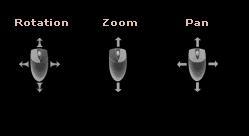
|
Ventricular fibrillation is an immediately life-threatening arrhythmia in which the heart's electrical activity and associated contractions become disordered and ineffective. It is characterized by rapid, irregular activation of the ventricles and thereby prevents an effective mechanical contraction. Blood pressure instantaneously drops to zero, leading to death within minutes due to lack of cardiac output unless successful electrical defibrillation is performed; spontaneous conversion to sinus rhythm is rare. During ventricular fibrillation, the ECG has no distinctive QRS complexes but instead consists of an undulating baseline of variable amplitude. Although the sinus node continues to function properly, P waves cannot be discerned in the VF waveform. Ventricular tachycardia in many cases can degenerate to ventricular fibrillation.
One mechanism believed to be responsible for the rapid, unsynchronized
contraction of the ventricles is the
continuous reactivation of one or more electrical circuits in the ventricles,
which can appear as three-dimensional spiral or scroll waves of
electrical activity. These waves prevent the ventricles from contracting
in a coordinated manner, thereby compromising the heart's ability to pump blood.
The contracting three-dimensional heart on the left can be rotated, zoomed, and panned by
clicking and moving the mouse as indicated.
|
